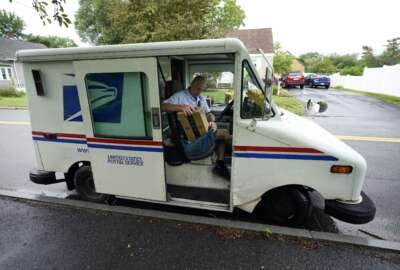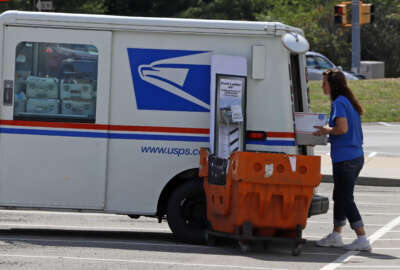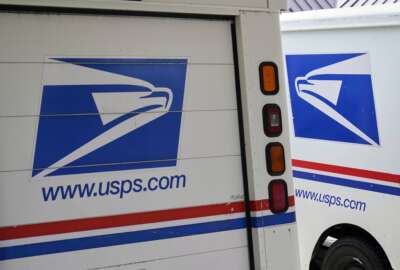Biden’s USPS board nominees plan to oversee reforms envisioned by Congress
President Joe Biden’s latest nominees to serve on the Postal Service’s Board of Governors are planning to oversee sweeping reforms at the agency, if confirmed.
President Joe Biden’s latest nominees to serve on the Postal Service’s Board of Governors are planning to oversee sweeping reforms at the agency, if confirmed.
Dan Tangherlini, the former head of the General Services Administration, and Derek Kan, a former deputy director of the Office of Management and Budget, told the Senate Homeland Security and Governmental Affairs Committee they would take a closer look at some lawmakers’ top priorities at the agency.
Those priorities include electric vehicles and the agency’s next-generation vehicle fleet, a data dashboard meant to track USPS service performance and the on-time delivery of election mail and mail-in ballots.
Congress outlined some of those reforms in the recently passed Postal Service Reform Act, the first USPS reform legislation to pass in 15 years.
“The work that this committee did on the Postal Service reform legislation really does set the stage for opportunities to dramatically improve the effectiveness and efficiency of the Postal Service,” Tangherlini said Thursday.
Committee Chairman Gary Peters (D-Mich.) said Tangherlini and Kan would play a “critical role” in implementing parts of the recently passed Postal Service Reform Act.
Lawmakers have also joined the Biden administration in pressuring USPS to purchase more electric vehicles as part of its next-generation fleet.
Tangherlini and Kan didn’t commit to setting higher electric vehicle targets for USPS, but said they would ensure the agency has the necessary infrastructure for electric vehicles.
Tangherlini, who previously served as the director of D.C.’s Department of Transportation and as interim general manager of the Washington Metropolitan Area Transit Authority, said D.C. navigated similar challenges switching over to hybrid electric buses and buses that run on natural gas.
“The actual cost wasn’t the vehicles itself, but the infrastructure, and then the need to make sure that the service ultimately that you’re responsible for is being delivered. At its core, it doesn’t matter what the vehicle is, as long as the mail is getting to people’s residences,” Tangherlini said.
Kan said one challenge in USPS acquiring electric vehicles is making sure it has the necessary charging infrastructure in the area.
“If we buy 10,000 electric vehicles and we deploy them to Montana, or to some rural parts of the country, there may not be the electrification of the grid to support these vehicles. I think a major pitfall is ensuring that all of the components needed for a procurement are in place,” Kan said.
Committee Ranking Member Rob Portman (R-Ohio) said nominees need to ensure that the capital investment in the USPS next-generation fleet is money well-spent.
“You could end up with a huge expense, either on the lack of infrastructure or on the maintenance and service side of this. So just being smart about it, I think, makes sense,” Portman said.
Sen. Tom Carper (D-Del.) said about 70% of the current USPS fleet has exceeded its 24-year service life. Many of the vehicles have been operating for 30 years, break down often and are more costly to maintain.
Carper said USPS, if it moved aggressively toward an electric vehicle fleet like its private-sector competitors, could help save on fuel and maintenance costs in the long run.
“The idea of ending up 10, 15, 20 years from now, with a fleet that is still largely gas and diesel, I think would be a huge missed opportunity,” Carper said.
Carper said Congress should find a way to appropriate money to USPS for electric vehicles.
“If we want to encourage the Postal Service to move away from gas and diesel vehicles, we have an obligation to help buy down the cost of those vehicles and buy down the cost of the infrastructure that will support them. And I hope we’ll keep our eyes on that,” Carper said
The House Oversight and Reform Committee plans to hold a hearing next week on USPS’s next-generation fleet and its plans for electric vehicles.
Both Tangherlini and Kan said USPS standing up a delivery performance dashboard, as required under the reform legislation, would help the agency address the root cause of delayed mail.
Kan, currently the chief business officer of the e-commerce fulfillment company Deliverr, said the dashboard would give the board “additional clarity” around USPS service problems.
“Are there splits between urban and rural? Are there splits across states? I think as we roll out some of these data reporting provisions, the more granular we can get, the better we can identify where there are specific problems,” Kan said.
Tangherlini said the dashboard would help create provide a more consistent level of service for customers.
“Creating clear expectations in terms of service delivery, creating clear expectations in terms of even delivering the tools that Congress has given the Postal Service, then, for people to evaluate and see that performance, is a fundamental responsibility of a governor, and should I be confirmed, that will be my highest priority,” he said.
Lawmakers also pressed the nominees to ensure USPS continues to strengthen their capacity to deliver election mail and mail-in ballots on time.
“We are very dependent on the Postal Service to ensure our election system works properly. It’s a good system that’s worked well, but if the vote doesn’t reach the election office in time, the election officials are handicapped, and people’s votes are not counted. Nothing could be more important,” Portman said.
While USPS earned bipartisan praise for successfully taking on an unprecedented volume of mail-in ballots during the 2020 presidential election, Portman said USPS should do more to work with state and local election officials.
Portman raised concerns with letters USPS sent to 46 states ahead of the 2020 general election, warning them that their state election rules for mail-in ballots were incongruous with USPS delivery standards.
“That’s a big problem. People vote and they expect their vote to count,” Portman said.
Portman said the committee is considering legislative proposals around USPS and election mail.
“I think it’s important that the Postal Service always be frank with what their capabilities are, but also improve those capabilities going into an election season,” Portman said.
Tangherlini and Kan also expressed optimism about USPS generating new streams of revenue from its more than 34,000 post offices across the country.
Both the USPS 10-year reform plan and Postal Service Reform Act urge the agency’s post offices to serve as a storefront for state and local government services.
“The Postal Service currently operates one of the largest pieces of infrastructure in the world today. I think figuring out ways to monetize that infrastructure, leveraging it, could be a way to increase top-line revenue,” Kan said.
Tangherlini said he would also look at ways to capitalize on USPS real-estate assets, and warned against downsizing it.
“We should be very careful about making any substantial changes to that asset without exploring the opportunities that we could realize more revenue from it,” he said.
Copyright © 2025 Federal News Network. All rights reserved. This website is not intended for users located within the European Economic Area.
Jory Heckman is a reporter at Federal News Network covering U.S. Postal Service, IRS, big data and technology issues.
Follow @jheckmanWFED






